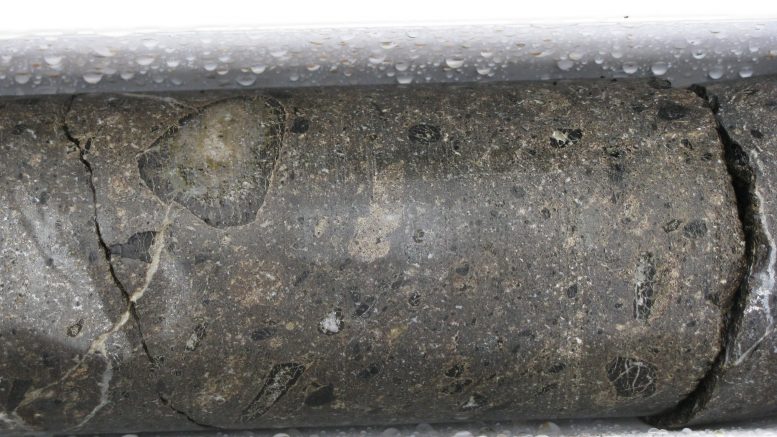Lithoquest Diamonds (TSXV: LDI; US-OTC: CWVWF) hit undiscovered kimberlite mid-year with the first hole at the company’s 1804 target on its North Kimberley diamond project in Western Australia. It was the first kimberlite discovery in the area in 20 years.
The company was drilling as part of its first fully fledged exploration campaign at North Kimberly. It drilled five targets during the program, including 1804. It also carried out geophysical surveying and sampling — rock, loam and stream sediment — to try to identify other targets in the area for future drilling.
The campaign based its targets on topographic features containing kimberlite indicators found in late 2017.
“Kimberlites occur in clusters,” Lithoquest CEO Bruce Counts says during a telephone interview with The Northern Miner. “We already collected rocks in four quite different locations and got indicator minerals. We might be looking at a new field of kimberlites here.”
He goes on to say that he formed Lithoquest to acquire and explore this property.
Counts’ interest in the North Kimberley dates back to 2015, when a colleague of his, Mike Dufresne, told him about rock samples collected in Western Australia in 2007.
Dufresne was trying to sample a kimberlite in the area called the KGB2 dike. According to Counts, not a lot is known — in the public domain at least — about KGB2, but it’s supposed to be located on top of the plateau that now hosts Lithoquest’s project.

“The discovery of kimberlite is a significant success given that no discoveries have been made in the area for 20 years,” says Bruce Counts, CEO of Lithoquest Diamonds (right), with Dave Skelton, principal technical consultant. Credit: Lithoquest Diamonds.
Dufresne landed in the KGB2 area and collected several rock samples that he thought could be weathered kimberlite.
“The rocks that Mike collected were fantastic,” Counts says. “The mineral chemistry is amongst the best I’ve seen in my career, and I’ve been in diamonds for quite a long time.”
Counts worked as a project geophysicist for BHP Billiton on the Ekati diamond mine in Northwest Territories, from before the discovery right through to mine construction.
As Canada’s first diamond mine, Ekati began production in October 1998. It has produced 67.8 million carats, with a mine life that extends to 2034. The largest gem-quality diamond it has produced was 186 carats.
Dufresne got his KGB2 results in time for 2008’s financial crisis, and had difficulty attracting interest in the project. On top of that, Counts says the mineral chemistry of the rocks Dufresne collected didn’t match up with what is known about KGB2.
What excited Counts, however, was that the rocks came from an area that had not had glaciation for hundreds of millions of years. The only things moving around rocks in the area are wind and water.

Drilling during Lithoquest’s recent campaign at its 100%-owned North Kimberley diamond project in Western Australia. Credit: Lithoquest.
“Indicator minerals in loam samples can travel much farther than in rock,” Counts says. “You’ve got to be pretty close to the source in this part of the world if you’re finding rocks that have indicator minerals in them.”
The company formed in 2016 and went to collect more rock samples from the property in April 2017. The results showed kimberlite indicator minerals in four locations across the project. It gave them the confidence to make the company public.
Lithoquest did a short geophysics and sampling program at the property in December 2017. It recovered three micro diamonds from a 10.06-kilogram outcrop rock sample at its 702 target. Two were yellow and one grey, and all ranged between the +0.1 mm to -0.3 mm size fraction.
With the company’s first field program behind it, Lithoquest awaits lab results it expects to see in the fourth quarter of 2018. The company’s field season stays open until December, when Western Australia’s wet season begins. It closes at the end of March.
The company says it may go back to develop new drill targets for 2018 and put in more work at 1804.
“Until the wet season starts you can drive right out into the property, so it’s pretty easy to send a geologist or a small crew of guys to go in and do some work on the property before the end of the year,” Counts says.
Shares of Lithoquest are trading at 27¢ with a 52-week range of 14¢ to 88¢. The company has a $12-million market capitalization. It has more than $2 million in cash.
“People have been pulling diamonds out of stream-sediment samples up on this plateau in particular for 40 years,” Counts says. “So there are diamonds around, but nobody has found the sources, as far as I can discern.”
Lithoquest hopes to be the first.


Be the first to comment on "Lithoquest drills kimberlite at North Kimberley in WA"